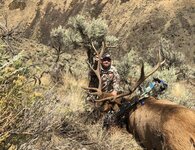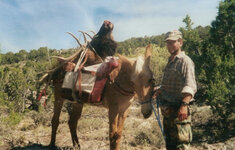If it’s mostly south it’s probably open and you should be able to glass effectively to find where they are hanging out. I’ve seen elk lay in wide open fields in the middle of August when it’s 100+ so they don’t always bed in timber. Is say the majority of the time they will though. They really like thick brush as well as timber, willow patches with water are elk magnets in dry country. I will say that every mountain has a north face though and north faces tend to hold more wildlife in general unless it is too thick for them to effectively move through.
I’ve killed elk in thick nasty vine maple, big dark open timber river bottoms, open grasslands and wide open sage brush without a tree in sight. One thing they need above everything else is water, if there is no water there won’t be elk.
This bull and 20 cows were bedded in the sage brush not far from this picture. I didn’t know he had that many cows until walking over to him after I killed him. There is water in the canyon behind me. There is also about 600 acres of dense forest less than a mile away so they don’t always go to cover. Typically they are going to go where they aren’t bothered, that could be heavy cover or a wide open hard to access bench or hillside.
View attachment 401278


